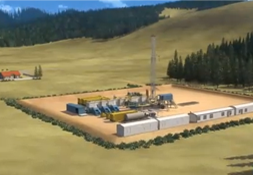Hydrofracking And The Debate Over Municipal Infrastructure
By admin on March 5, 2013
 On February 11, 2013, the IADC conducted a lively, interactive panel discussing the risks and benefits of shale oil and gas extraction at the IADC Mid-Winter Meeting. The panel represented the spectrum of political, regulatory and scientific views on the issue and debated perceived potential risks to human health and the environment.
On February 11, 2013, the IADC conducted a lively, interactive panel discussing the risks and benefits of shale oil and gas extraction at the IADC Mid-Winter Meeting. The panel represented the spectrum of political, regulatory and scientific views on the issue and debated perceived potential risks to human health and the environment.
In addition to me, the panel consisted of Blaine D. Edwards, Assistant General Counsel at Superior Energy Services, Inc.; Raymond G. Mullady, Jr., a partner at Blank Rome LLP in Washington, D.C.; and Niall A. Paul and Nathan D. Atkinson, partners at Spilman Thomas & Battle PLLC. Eric Lasker at Hollingsworth LLP in Washington, D.C. assisted in the preparation and coordination of the event.
Ray Mullady presented his paper, “Defending Marcellus Shale Groundwater Contamination Claims: The Case Against Class Actions and Other Theories of Liability,” which he co-authored with other lawyers at his firm. I presented my paper titled, “Shale Oil and Gas Development: The Stakeholder Perspective.”
My paper concerning stakeholder perspectives was presented against the backdrop of the debate in New York concerning whether to permit fracking to occur. In researching this issue, I learned that some stakeholders representing county and municipal interests expressed deep concern regarding perceived secondary societal impacts of fracking, including diminution of property value; increased demands placed on community infrastructure, particularly roads; increased crime rates and rental prices associated with an influx of out-of-state workers; and the fragmentation of rural landscapes with pipelines, roads and staging areas. Surprisingly, for these stakeholders, these concerns outweighed environmental or health concerns.
These stakeholders express deeply held fears – whether rational or not – that gas exploration will be detrimental to their established way of life in rural upstate New York.
The natural gas industry possesses both the science and the practical know-how to be confident that fracking can be performed without causing the contamination of groundwater and surface water. However, social concerns raise questions beyond purely environmental issues. In a largely rural region that is unaccustomed to the perceived sprawling industrial impact of natural gas drilling, unlike other parts of the country, there is apprehension that adverse societal effects may outweigh the predicted economic benefits.
There are a number of tools an industry can utilize to address concerns over infrastructure impacts of hydrofracking. Better public relations to win over the hearts and minds of upstate New Yorkers is paramount. Perhaps because public relations efforts have not been necessary in other areas of the country long accustomed to natural gas exploration, there may not have been a perceived need for PR in upstate New York.
Explaining how horizontal drilling works is an important first step in reassuring folks that gas exploration will not bring about an end to their semi-agrarian way of life. For example, there is a superb animation that explains how horizontal drilling works on the website of the Oklahoma Oil & Natural Gas Producers & Royalty Owners. In the immediate vicinity of drilling operations, companies can provide, among other things, Value Assurance Programs (“VAPs”) to homeowners to protect them against diminution of property value as a result of their living in an area where industrial activity is taking place. As discussed in other articles on this blog, a VAP is a contractual commitment to the community that assures homeowners that the proposed activity will not result in loss of investment in their homes. 
Any day now, the blue ribbon panel appointed by NYS Health Commissioner, Dr. Nirav Shah, to assist in the NYSDOH’s consideration of the health risks of fracking, will issue its report. The panel experts – Lynn Goldman, dean of George Washington University’s School of Public Health and Health Services; John Adgate, chair of the Environmental and Occupational Health Department at the Colorado School of Public Health; and Richard Jackson, chair of the Department of Environmental Health Sciences at UCLA’s Fielding School of Public Health – are among the foremost experts in the country in their respective fields and in the field of health impact assessment. Environmental advocacy groups, including NRDC, were extremely pleased with these appointments. It is likely that the issuance of the panel’s report will re-energize the hydrofracking debate.
